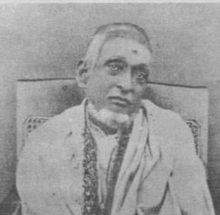| Korada Ramachandra Sastri | |
|---|---|
 Poet and Playwright in Sanskrit and Telugu Poet and Playwright in Sanskrit and Telugu | |
| Born | Korada Ramachandra Sastri 12 October 1815 Kesanakurru, A. P., India |
| Died | 11 August 1900 Machilipatnam, India |
| Occupation | Telugu Pandit at Nobel College, Machilipatnam |
| Notable works | Manjari Madhukariamu, Nayapradipamu (Vigrahamu) Ghanavrttam , Upamavali, Kumarodayaha |
| Spouse | Seetamma |
| Relatives | Korada Ramakrishnaiya, Korada Mahadeva Sastri, Korada Subrahmanyam |
| Website | |
| thekorada | |
Korada Ramachandra Sastri (12 October 1815 – 11 August 1900) was an Indian poet and playwright in Sanskrit and Telugu. He was the first known original Telugu playwright. His Manjarimadhukariam is the first Telugu drama with an original concept. His Sanskrit lyric poem Ghanavrttam is a sequel to Kalidasa's Meghaduta. Ramachandra Sastri authored more than thirty works in Sanskrit and Telugu but only a few books are extant. His books give us an appreciation of the advanced poetic and linguistic aspects of his literary works.
Sanskrit books
- Ghanavrttam is a sequel to Kalidasa's Meghaduta. Meghaduta stops with Yaksha’s message to the cloud. Ghanavrttam completes the story – the cloud messenger goes to Alakapuri where he delivers the message and returns to Yaksha with the beloved's message. The story ends with the reunion of the couple. This lyric poem consists of 175 verses in two chapters.
- Upamavali is a kavya on alankara-sastra, the science of aesthetics, embellishments, and beauty. It has 358 slokas in two chapters.
- Kumarodayah Champu is a maha kavya, resembling Kalidasa's Kumarasambhavam but in Champu style. The work is divided into 27 chapters with terse verse interspersed among prose sections.
Telugu books
- Manjarimadhukariamu (pronounced 'Manjaree Madhukareeyamu' in Telugu) is the first original Telugu drama. It tells the story of King Madhukara's marriage to princess Manjari. Madhukara encounters the princess in a dream and resolves to find and marry her. He becomes forlorn and despondent after a futile search, and his queen does not know why. Manjari suffers Chandayogini's witchcraft and lands in the queen's palace. The queen hides away the beautiful princess Manjari from the king. She soon realizes the reason for the king’s despondency and learns that Manjari is her own cousin. The queen arranges for the marriage uniting Manjari and Madhukara. As noted by Amaresh Datta, chief editor, Encyclopedia of Indian Literature, "though none of the early plays of dramatists were put on board, they paved the way for modern Telugu Drama."
- Parsurama Vijayamu is an original prose work of the author describing the victory of Parasurama.
Sanskrit to Telugu translations
- Nayapradipamu is a Telugu translation to Vishnu Sharma's Panchatantra (Vigrahamu) in Sanskrit.
- Rathangadutamu is a Sanskrit to Telugu translation of the sandesa kavya of the same name.
- Unmattaraghavamu is Ramachandra Sastri's Telugu translation of Bhaskara Kavi's Sanskrit original.
- Satika Andhra Samasa Nalacharitramu is a Telugu translation of the Sanskrit work Nalacharitram with word to word meaning and translation.
References
- ^ Natarajan, Nalini; Nelson, Emmanuel Sampath (1996). Handbook of Twentieth-century Literatures of India. Greenwood Publishing Group. ISBN 978-0-313-28778-7. Archived from the original on 2021-10-03. Retrieved 2021-10-03.
- ^ B, Ramaraju (2002). Contribution of Andhra to Samskrit Literature. B. Ramaraju. pp. 433–442.
- ^ P, Sriramamurti (1972). Contribution of Andhra to Sanskrit Literature. Andhra University. p. 163.
- ^ History of Telugu Literature. New Delhi: Sahitya Academy. 1968. p. 262.
- Korada Vamsa Prashasti. 1951.
- Sinha, Biswajit (2000). Encyclopaedia of Indian Theatre: South Indian Theatre, Biswajit Sinha · 2000. Raj Publications. ISBN 9788186208540. Archived from the original on 2021-10-03. Retrieved 2021-09-16.
- ^ Dutta, Amaresh (1988). Encyclopedia of Indian Literature. Delhi: Sahitya Academi. p. 1114. ISBN 81-260-1194-7. Archived from the original on 2021-09-27. Retrieved 2021-09-27.
- ^ Manjarimadhukariam : First original Telugu drama (in Telugu). 1908.
- Ponangi, Srirama Apparao (1967). Telugu Nataka Vikasam (in Telugu). Secunderabad: Natyamala Publications. p. 218.
- Sri Korada Ramachandra Sastri (1850). GHANAVRTTAM Devanagari Script.
- "Ramachandra Sastri". Archived from the original on 2021-09-10. Retrieved 2021-09-16.
- Sri Korada Ramachandra Sastri (1850). GHANAVRTTAM Devanagari Script.
- Korada Ramachandra Sastri (1917). Ghanavritham (a sequel to Kalidasa's Meghadutam).
- Korada Ramachandra Sastri (1850). Upamavali (Telugu script).
- Korada Ramachandra Sastri (1850). UPAMAVALI Devanagari Script.
- Korāḍa Rāmacandra (1910). Kumārōdayaḥa. Macilīpaṭnaṃ: Yaṃ. Śēṣācalaṃnāyuḍu Pabliṣarsu aṇḍ Priṇṭars. OCLC 77404130.
- Korāḍa Rāmacandra (1908). Mañjarī madhukarīyamu. Masulipatnam: O.M.S. Dove Press. OCLC 77411306.
- Korāḍa Rāmacandra (1927). Paruśurāma vijayamu: gadya kāvyamu. Vijayanagaramu: Yas. Vi. Vi. Pres. OCLC 77404623.
- Korāḍa Rāmacandra (1930). Nayapradīpamu-vigrahamu: gadyamu. Cennapuri: Āryabhārati Pres. OCLC 44756136.
- Korāḍa Rāmacandra; Rāmakr̥ṣṇayya, Kē (1930). Rathāṅga dūtamu: rathamu. Cennapuri: Rājarājēśvarī Nikētana Pressu. OCLC 80875334.
- Korada Ramachandra Sastri (1880). Unmatta Raghavamu.
- Korāḍa Rāmacandra (1872). Saṭīkāndrasamāsa naḷacaritramu. Macilībandaru: Kēśavarāju aṇḍ Kampenī. OCLC 77411708.
External links
- Manjarimadhukariam at the Internet Archive
- Ghanavritham at the Internet Archive
This article about an Indian writer or poet is a stub. You can help Misplaced Pages by expanding it. |
This article about a dramatist or playwright is a stub. You can help Misplaced Pages by expanding it. |